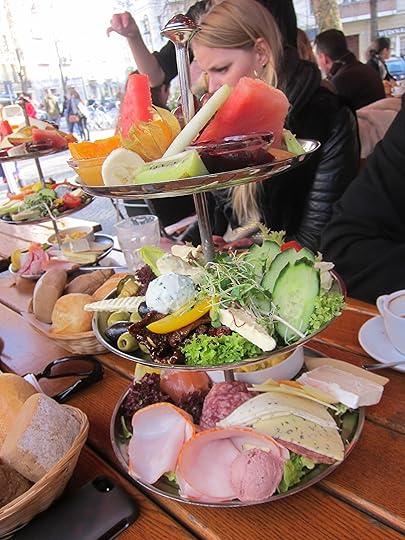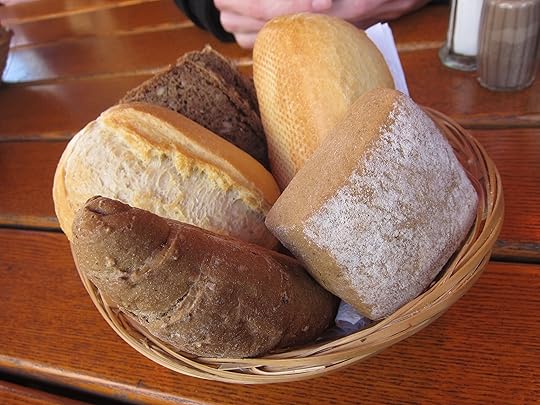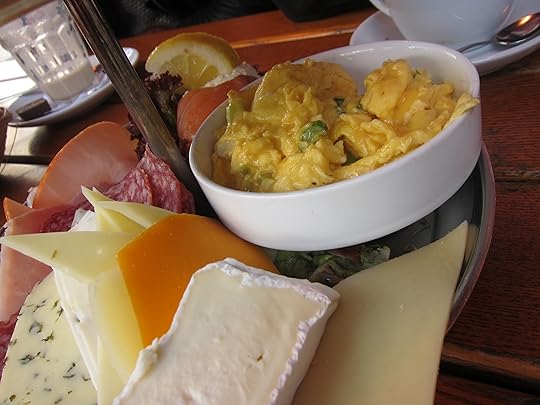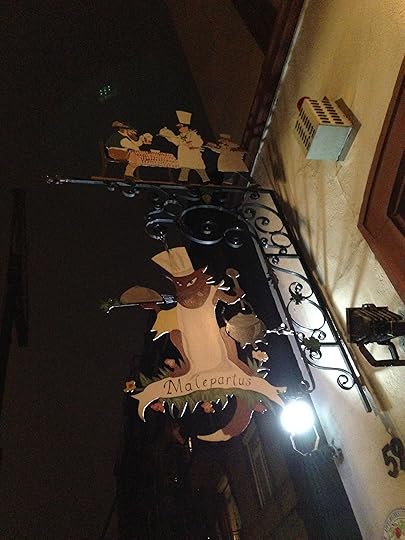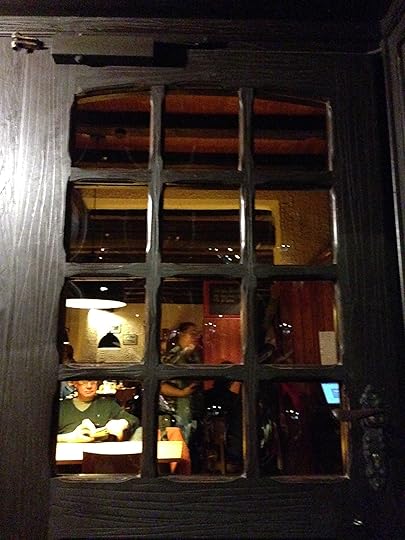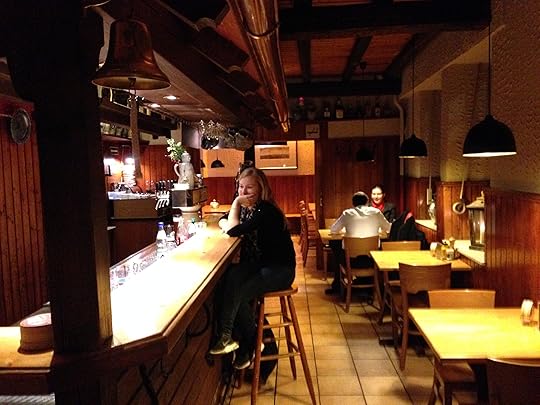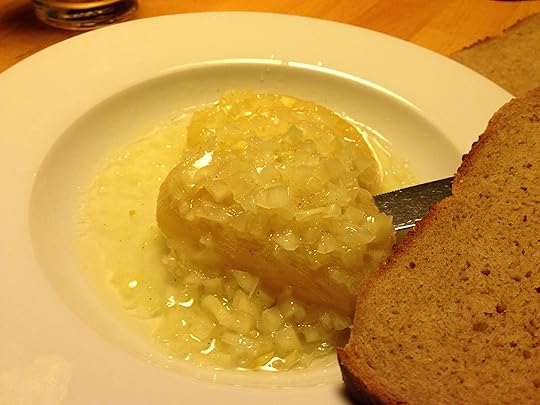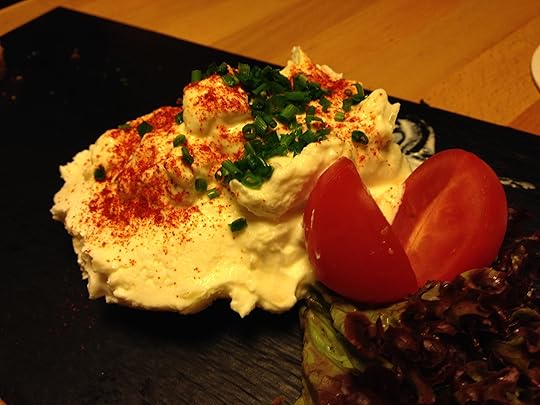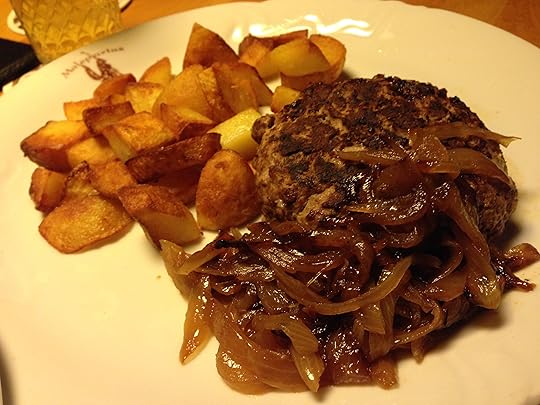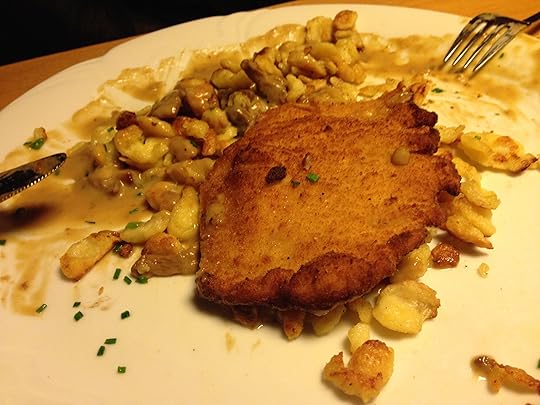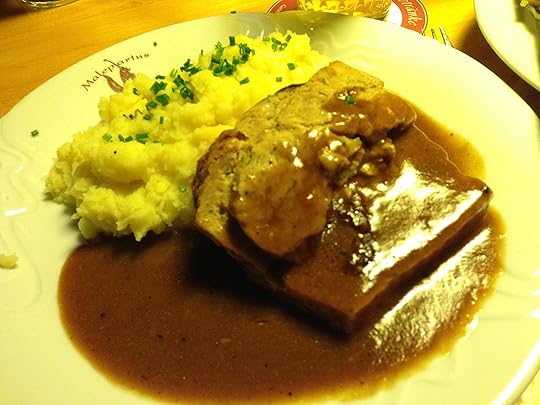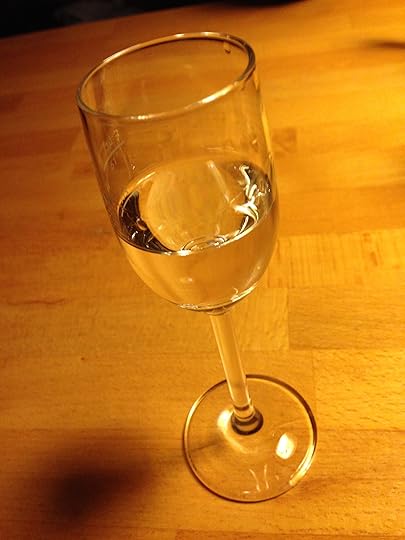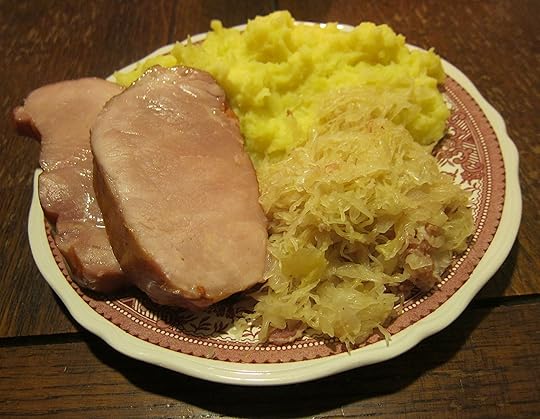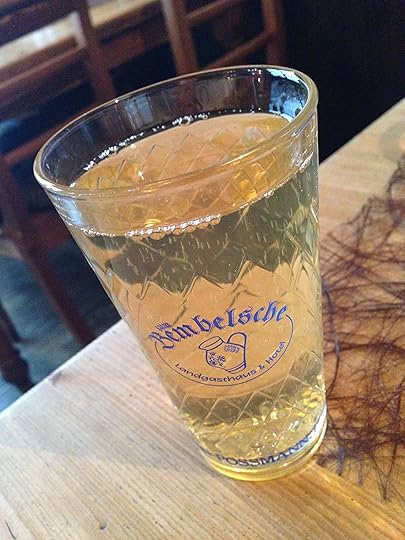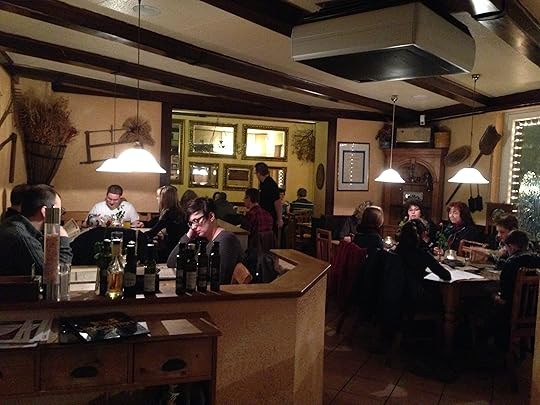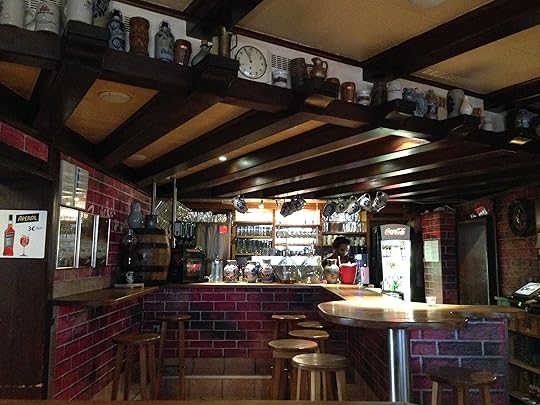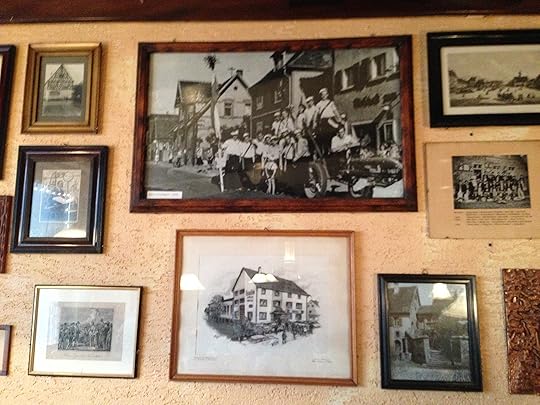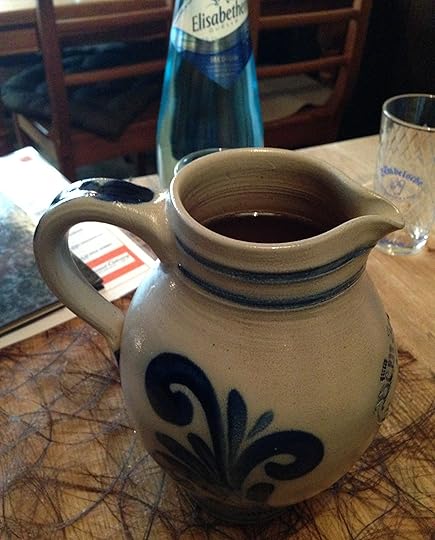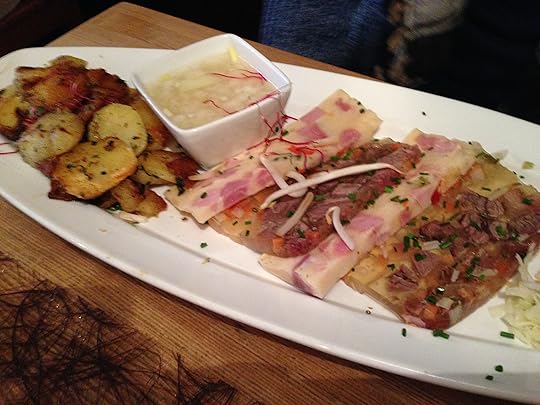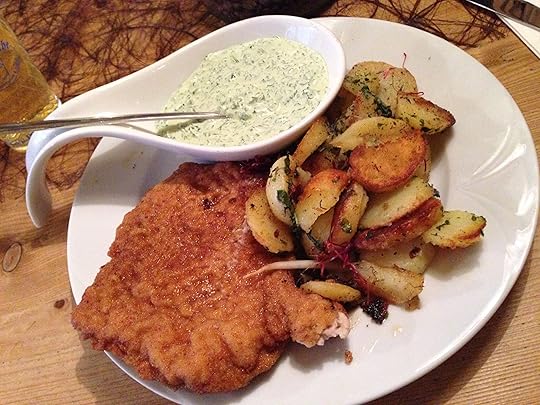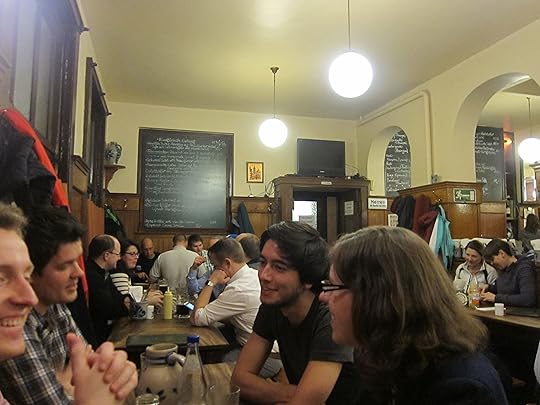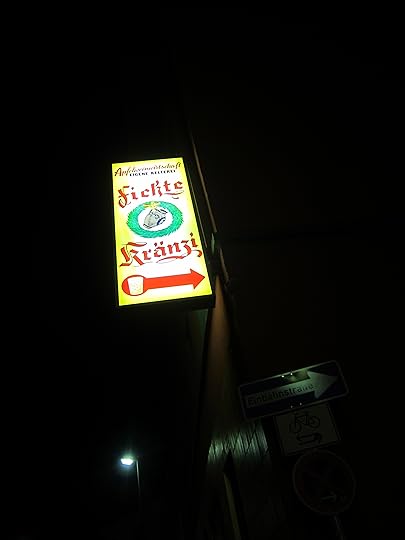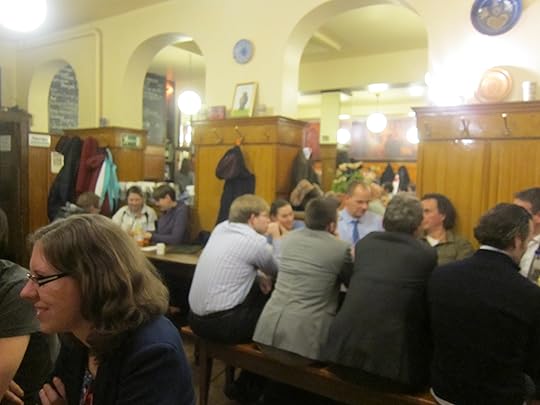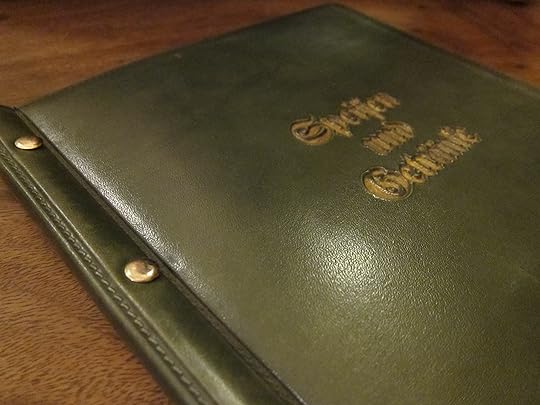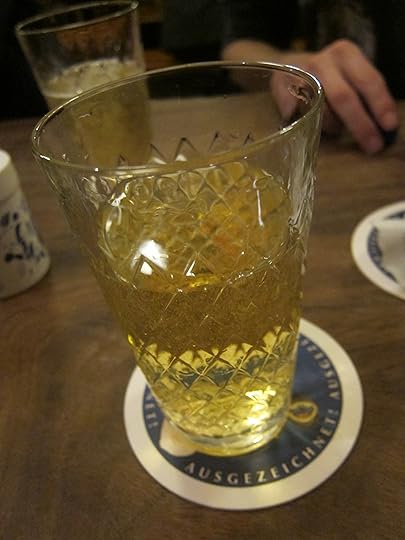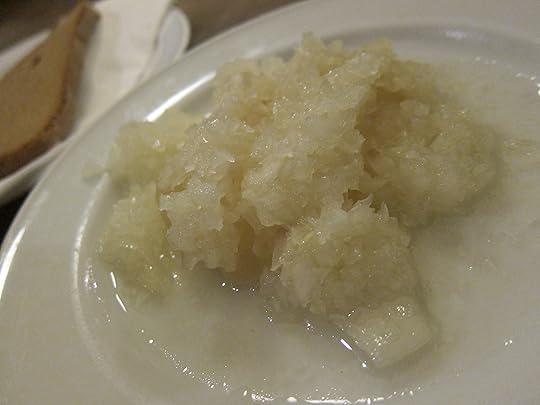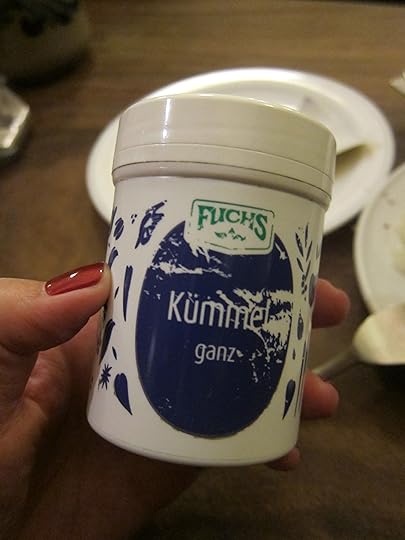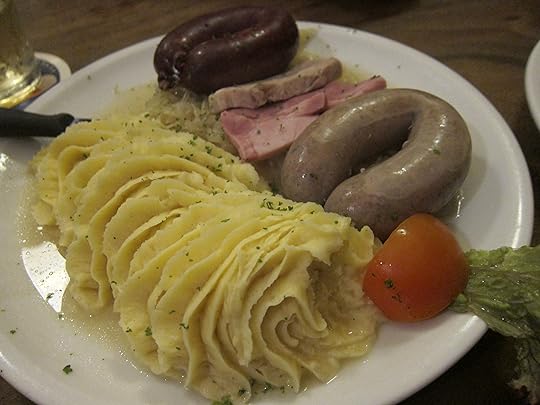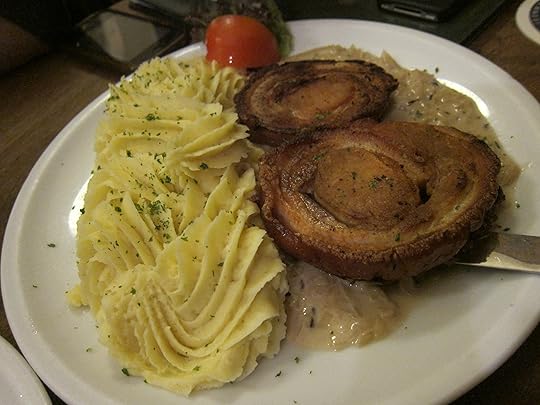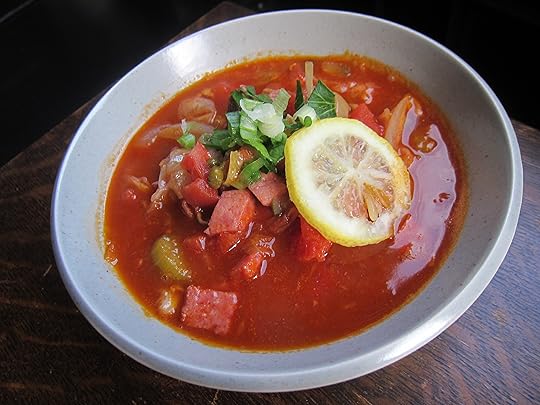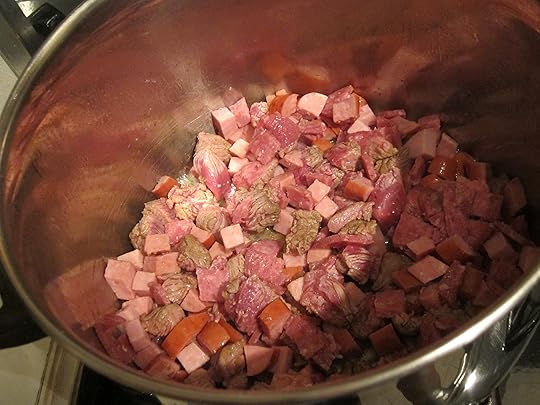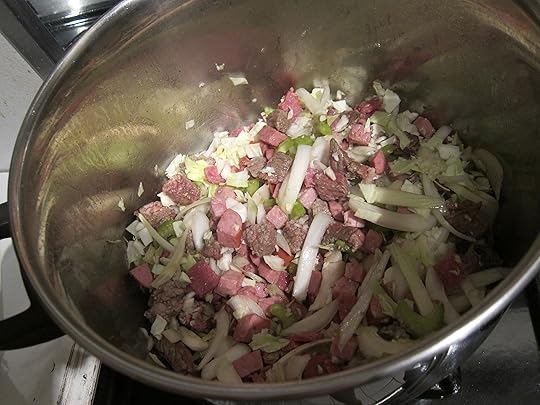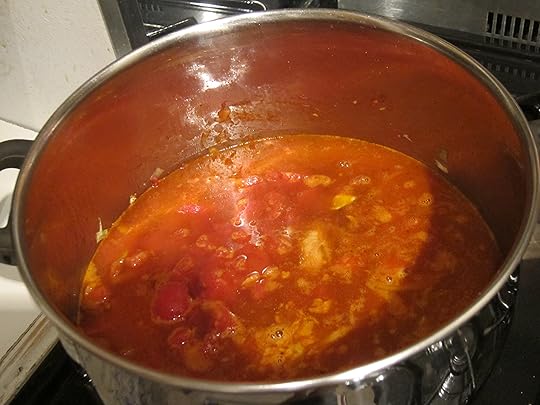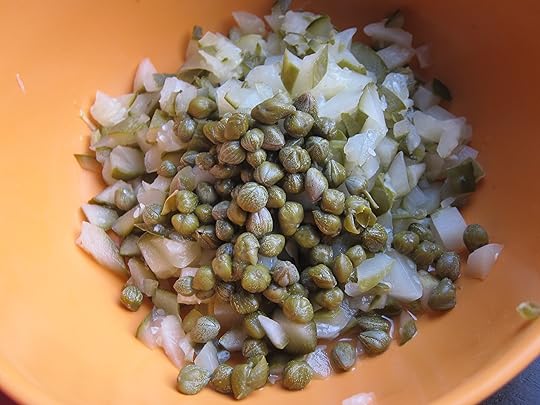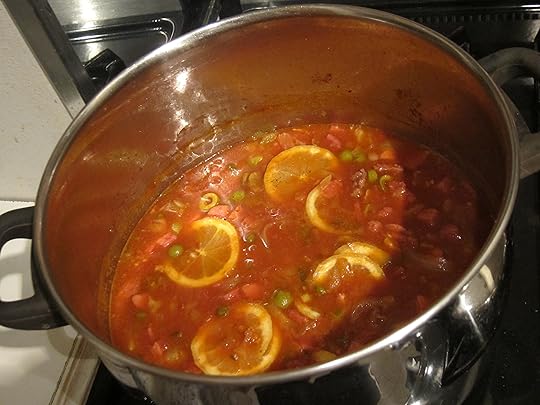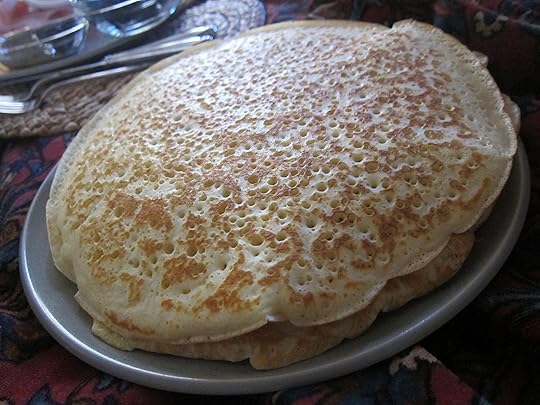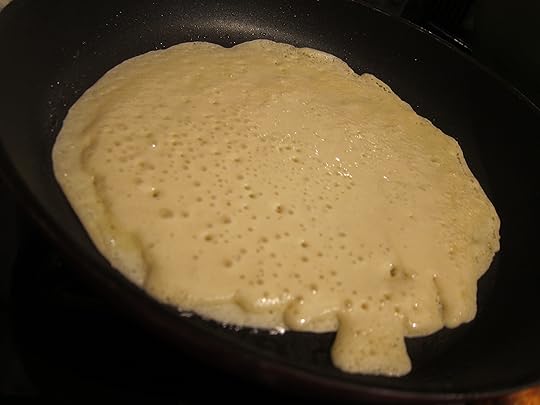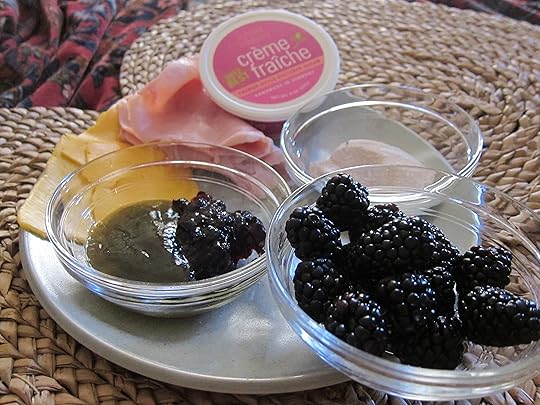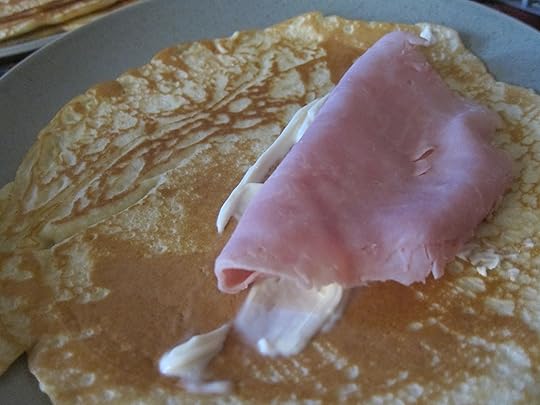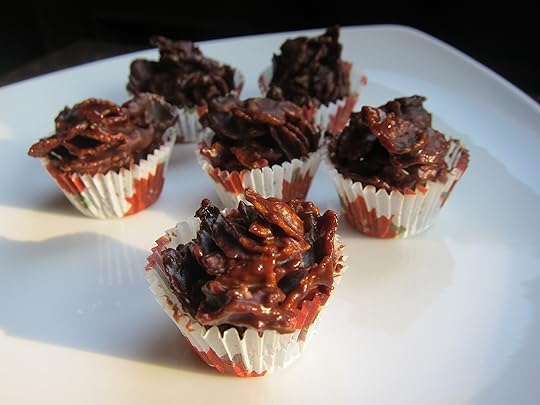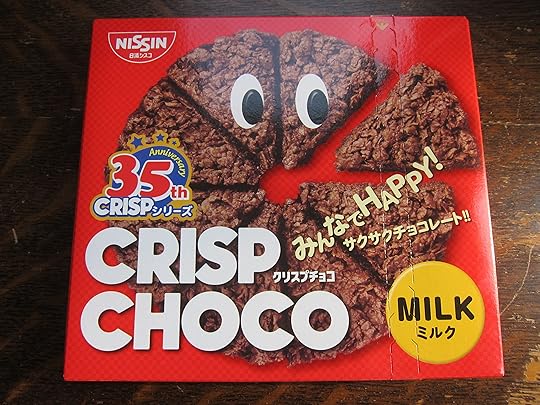Cheryl Lu-Lien Tan's Blog
June 10, 2015
Protected: Hibino (Brooklyn):
This post is password protected. To view it please enter your password below:
Password:
February 28, 2014
Anna Blume (Berlin): A Towering Brunch
“Brunch,” I was told my first day in town, “is big in Berlin.”
Having just come from New York, a city where weekend brunch is practically a religion, I almost snorted, wondering how different or striking this meal could possibly be in Berlin.
As my host led me down the cobblestoned streets of the city’s fashionable Prenzlauer Berg neighborhood, however, I quickly realized my folly …
Now, if you’ve never been to Prenzlauer Berg, it’s pretty much the West Village of Berlin. And on a sunny Sunday in February, even though there’s still a clear nip in the air, every restaurant with sizeable sidewalk space or a terrace is bursting at the seams with well-heeled brunchers huddled under heating lamps, bundled up in restaurant-issued blankets. (The latter is my favorite detail about Berlin outdoor dining — cozy blankets!)
The options make this still jet-lagged head spin — should we stop for a Russian feast of smoked fish and blintzes at Pasternak or a Middle Eastern buffet of hummus and pastas just next door?
In the end, a classic Berlin brunch beckons and Anna Blume it is.
This place is a favorite not just of my host but also just about half of Berlin, it seems from the packed tables spilling out far into the sidewalk. Named for a poem that German artist Kurt Schwitters penned in 1919, the restaurant is also a flower shop, which gives the place a lovely scent and setting.
The menu is hefty, filled with omelets, crepes, sandwiches and more. But judging from the tables all around us, the set brunch (17,50 Euros for two people) — served in three-tiered towers overflowing with meats, cheeses, fruit, spreads, salad, eggs and smoked fish, is the way to go.
A basket of bread arrives almost immediately. (I’m jumping ahead a little here but each of these rolls was just terrific.)
But the star of this show, of course, was the towering brunch smorgasbord before us. There were six kinds of cheese, delicious sliced meats, smoked fish, pate and just about the creamiest, tastiest, most perfectly done scrambled eggs I’ve tasted.
When we’d worked our way through as much of the savory as we could, the sweet and tart jams and deliciously rich butters were a fantastic capper with more of that fabulous bread.
Sadly, even though I’d arrived famished, I ended up not eating it all. The temptation to sip more coffee and keep nibbling was there but just a few steps away lay sunshine, beautiful Berlin streets, a city to explore.
And after this meal, I was more than fortified for the expedition. My host had been right — these Berlin brunches, they’re big.
Anna Blume, Kollwitzstraße 83, 10435 Berlin, Germany; +49.30.44048641; http://www.cafe-anna-blume.de/
February 25, 2014
Dong Xuan Quan (Berlin): A Vietnamese Pho Fix
It only took about a week into my visit to Germany but suddenly, there it was: My massive craving for a bowl of hot noodle soup.
Good thing I was in Berlin — I’d been told before getting here that there’s good food to be had in this city. Vietnamese immigrants, after all, have been a fixture in Berlin since as early as the 1950s, when East Germany began extending invitations to North Vietnamese to come over for training programs.
Where to go? All signs pointed to a spot in East Berlin’s Lichtenberg neighborhood named Dong Xuan Center …
From all I’d heard of this place, it’s basically a giant parking lot filled with warehouses that are packed with Vietnamese eateries and stalls.
This certainly was true. Although, early on a weekday morning, I wondered, where are all the cars?
A little bit of sleuthing — and attempts to open various doors into the four warehouses — revealed that I had simply chosen to go to Dong Xuan Center on the one day of the week that it is closed: Tuesday.
Just when I was about to give up on my noodle quest, I spied a man entering a door …
… and followed him in. The place was cavernous and largely empty, filled with the dank air of last night’s cigarette smoke — but, it was open.
Nodding a little hello to a quartet of older gents sitting in a corner sipping coffee and smoking, I sat down and ordered right away.
First up, iced Vietnamese coffee. At 4 Euros, I have to confess I expected some mind-blowing iced coffee. This was pretty good (if you like super thick coffee that’s almost the consistency of heavy cream) — but not the best I’ve had.
The menu is a hefty one here — the pho section alone has almost 10 selections. Since I read very little German and even less Vietnamese, I went with the most basic beef pho (6 Euros).
These appeared right away — super spicy red chilies, which I much prefer to the usual sliced jalapenos served in U.S. pho joints.
And then, a gigantic bowl of pho (above) that came so filled with flat rice noodles and slivers of beef that there actually wasn’t that much broth. The meat was nicely done — flavorful and tender, laced with buttery chunks of fat — and each spoonful of broth, packed with chopped cilantro and spring onions, was spicy and intense, even before I added any chilis.
As I pondered the suddenly empty bowl before me, I thought about what other treats all those closed stalls and restaurants in Dong Xuan Center’s warehouses must hold.
Tomorrow, then — I’ll be back.
Dong Xuan Quan, Herzbergstrasse 128 – 139, Halle 1, 10365 Berlin, Germany; 030.680.77.845; mactam05@yahoo.de
February 23, 2014
Malepartus (Frankfurt): A Fressnarkose (Food Coma) Feast
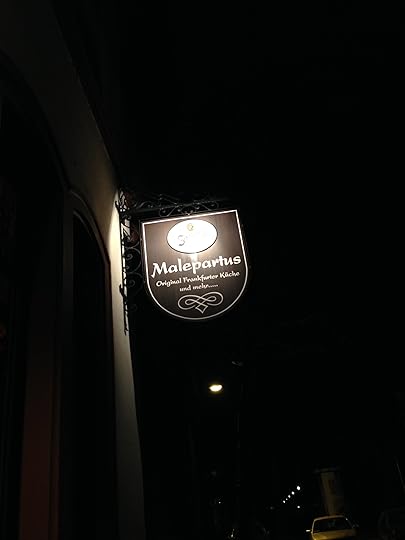 I’m a big believer in eating in red-light districts.
I’m a big believer in eating in red-light districts.
In Asia at least, that’s where you can often find good food that’s fairly cheap in settings that are open deep into the night.
It turns out that this sometimes holds true even for gentrified neighborhoods that once were red-light districts — at least that’s what I discovered during a recent jaunt to Frankfurt’s Bornheim, a city district once called “Das lustige Dorf” (“The Merry Village”) because of the evening hotbed that it was more than 100 years ago …
Bornheim appears to be something like the Greenwich Village of Frankfurt. Filled with the young and creative, and a plethora of bars and restaurants that’ll appeal to said crowd, it’s certainly a prime spot to find a good meal.
And so a merry band of us found ourselves wandering the dark streets on a recent night, led by an illustrator who lives in the neighborhood.
A traditional Frankfurt place, she had said. Just simple local food. And suddenly, there we were.
If the sign didn’t intrigue me enough, the door certainly did. (Glass detailing in doors always makes me weak-kneed.)
The decor was no nonsense; the crowd (in the other, main, room) fairly rambunctious.
We began with a standard – Handkäse mit Musik (4,20 Euros), a spongey local cheese topped with minced onions marinated in vinegar.
This pungent dish, I was told, doesn’t usually go over well with non-locals. Not this tourist, however. And this rendition was terrific — lovely, tart and tangy, delicious on bread. Our table ended up polishing off two rounds of this dish.
Because one can never have too much cheese, we sampled another local cheese appetizer: Schneegestöber (4,50 E).
This classic Frankfurt dish — which means “snow flurries” — features one of my favorite cheeses, Camembert, which is pureed together with butter, egg, onions and then topped with paprika, pepper and chives.
I don’t think I need to tell you how tasty it was — the ingredients say it all. The consistency, however, was what really got me. It was so airy and whipped it felt like a cheesy cloud on the tongue.
The boys seemed to be of like minds, each getting a grilled chopped steak (11,50 E), which came topped with sauteed onions and beautifully crisp potatoes. Straightforward, good stuff.
The schnitzel with spätzle (11,80 E) was probably the best deal on the table — I got to this dish too late but trust me when I say that the schnitzel was pretty much the size of the entire plate. And deliciously crisp, too.
Now, if you’ve read “A Tiger in the Kitchen,” you’re probably aware of my obsession with meatloaf. So when someone explained that Hackbraten (10,50 E) is German meatloaf, I was sold.
And I certainly didn’t regret it. The meatloaf was falling-apart tender, moist and incredibly tasty on its own, though fantastic slathered with earthy mushroom gravy, too. And the mashed potatoes were buttered perfection.
By this point, our jugs of local apple wine had disappeared. A digestif was in order.
In a flash, a round of little glasses filled with fruit appeared — mispelchen (3,20 E), a sort of German Calvados. I’m not the biggest Calvados fan but this was lovely — not too heavy, not too sweet. And each bite of the alcohol-drenched mispel — a little fruit that’s a cross between an apple and a pear — was a delight.
As we chewed on our mispels, the locals pondered a next step. “Schnaps!” someone said. And magically, a round appeared.
On the table were a few kinds — hazelnut, pear and apricot. After sampling them all, I probably leaned toward the fresh taste of fruity rather than the richness of the nutty.
As our feast drew to a close, my guide leaned over and said, “We have a great word in Germany — fressnarkose,” which means “feeding on anesthetic,” or something like eating yourself into a narcotic state. (A much cooler version of the English food coma.)
“This,” my host continued, leaning back in his chair, “is fressnarkose.”
Malepartus, Bornheimer Landwehr 59, 60385 Frankfurt; +49.69.447910; http://www.malepartus-frankfurt.de/
February 21, 2014
Kasseler Mit Puree Und Kraut: German Smoked Pork Bliss
I used to think there was nothing better than waking up in the morning to the smell of bacon frying in the kitchen.
And then I woke up one afternoon from a deliciously languorous nap, having fallen asleep with a book on my chest, to the smell of bacon frying in the kitchen.
The bacon was just the first sign of a terrific meal ahead. What was on the menu? Kasseler mit puree und kraut — smoked cured pork neck with sweet buttery mashed potatoes and bacon-inflected sauerkraut …
I’d like to offer a recipe, but this being Germany, all the components were pretty easily attained. The log of kasseler was purchased cured and ready for warming up in the oven; the mashed potatoes were pretty straightforward — though, the chef said to be sure to add lots of butter and boil the potatoes with the skins on, peeling them after, so they’re more flavorful and sweet.
The sauerkraut was tweaked, though. Minced bacon and onions were fried up in butter before being mixed in with the kraut and heated through.
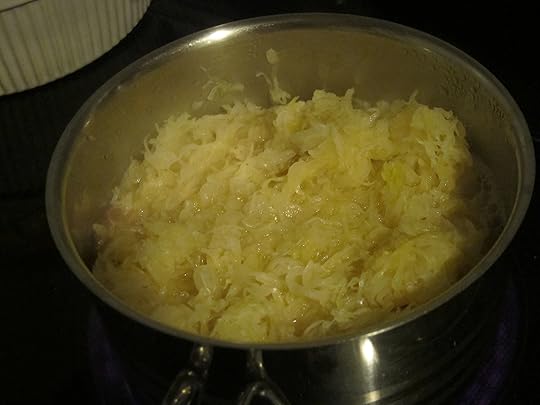 And how was it all? Very very tasty, especially if the sweet buttery mash, tangy sauerkraut and rich, smoky pork are combined in a large bite. Just the thing to climb out of a nap to find on the dinner table.
And how was it all? Very very tasty, especially if the sweet buttery mash, tangy sauerkraut and rich, smoky pork are combined in a large bite. Just the thing to climb out of a nap to find on the dinner table.
And, the perfect prelude to yet another nap.
February 20, 2014
Zum Bembelsche (Raunheim, Germany): Apple Wine & Schnitzel, Classic Frankfurt
Of course I landed in Frankfurt hungry. Starving, really.
Not to mention exhausted, grumpy — and did I mention famished? Which is, as you might guess, not the best combination.
With the goal being to feed me — and fast — we decided to step into a place that popped up on a road nearby. Now, as someone who tends to like researching places before I pick up a fork there, I wondered, would this random choice near the woods of Raunheim, Germany, be OK?
The sound of its name — Bembelsche, which means jug of apple wine, the local specialty — was promising though. And schnitzel was on the menu.
So hey, we thought, this can’t be bad …
It turns out that Zum Bembelsche Landgasthaus & Hotel is something of a local favorite.
Its decor is modern rustic country inn — which it is.
And although pictures on the wall show the house and town in old photos, this restaurant has actually only been around since 1999.
We weren’t there to ruminate on Raunheim history and gastropub lore, however. There was a task at hand — and so we began.
First up, bembelsche. As my host explained, apple wine is a Frankfurt classic — a must, really. You can have it two ways — with Sprite, if you have a sweet tooth, and with seltzer water, if you prefer things a little sour. All you do is fill a glass about 75% with apple wine, then top it off with your beverage of choice.
The Sprite version tasted a little too candied for me so seltzer it was. Slightly tart and fizzy with just a hint of sweet apples, this was delicious.
The menu is devoted to Hessian cuisine — food of the Hesse region, in which Frankfurt is the biggest city. This means it’s super meat- and schnitzel-heavy — all the things I love, basically.
To begin, there was the Sülzenauswahl, a platter of house-made beef and pork aspics with fried potatoes (8,40 Euros). I’m not the biggest aspic fan but these were rather tasty — gelatinous, fatty and meaty, in all the good ways.
And the potatoes — oh, the potatoes. These thin slices were fried so well there was a good layer of crunch, with a nice char, on each piece.
What I had really been looking forward to, however, was my first schnitzel in Germany.
If you’ve been reading this blog — or anything I have ever written about food — you may have picked up on my great love for hearty hunks of meat and breaded fried food. Schnitzel, of course, combines the two. Sheer brilliance!
Zum Bembelsche celebrates this dish in several ways — you can have it alone, stuffed with ham and cheese or topped with mushrooms, bell peppers or spicy pepper-cream sauce.
“Get the green sauce,” my host said. “It’s the traditional Frankfurt dish.”
So I did (8,90 E). And man, did this super-thick, creamy sauce pack a punch — it’s green because it’s just filled with herbs. Not only that — there were added treats in the form of bits of chopped hard-boiled eggs mixed into it.
The schnitzel arrived just south of singe-your-tongue hot — and fried to perfection. The crust was super crisp and the meat, juicy and tender. Paired with giant globs of chilled green sauce, each bite of this schnitzel was divine.
As I wiped my plate clean, I considered my luck in having this be my very first meal in Germany.
If a random restaurant on a random straße in a small German town could serve up such wunderbar food, surely only great meals lay ahead.
I couldn’t wait to be hungry again.
Zum Bembelsche Landgasthaus & Hotel, Mainzer Straße 53, 65479 Raunheim, Germany; +49.6142.929292; http://www.bembelsche.com/pu/index.htm
February 19, 2014
Fichtekränzi (Frankfurt): German History on a Plate
A girl’s first time in Germany and of course, old-school taverns are a must. In Frankfurt, that means one kind in particular — a traditional Äpplerkneipe, or apple wine bar. And if you’re going to check one out, it’s simply got to be Fichtekränzi.
Dating back to 1849, this place — one of the oldest apple wine bars in the city — oozes tradition. The menu is packed with schnitzel, sausage platters, pork knuckles and more, and the setting, though filled with the young and well-heeled parking their fashionable rumps on long wooden benches, is decidedly rooted in the 19th Century.
I know all this now — but before getting there, I hadn’t been told much about this place by the native Frankfurter showing me around, so I wasn’t sure what to expect as we slowly wended our way down the banks of the tranquil Main River, along a series of narrow lanes, before turning into an alley.
What lay beyond? I couldn’t wait to find out …
This was the first sign in the darkness that something was in store.
The name and logo of the restaurant is all about apple wine, the local beverage to have. For hundreds of years now, a ring of intertwined branches of spruce — fichte — apparently has conveyed that an establishment served apple wine.
And once we got inside, it was clear from the pitchers on tables that many were there to enjoy it.
The menu — like its contents — was a throwback.
We knew what we wanted to drink without looking, of course: Apfelwein. (Jugs cost 5, 7 or 10 Euros.)
You can have this two ways — sweet (mixed with Sprite) or slightly sour (mixed with Seltzer). I’m more a fan of tart than sweet, so Seltzer it was and this was delicious. The taste is not so much like an American or British cider — more like a subtle apple-tinged wine. The addition of Seltzer amps up its energy a little, giving each sip a pleasant zing.
What to eat with it? Another local specialty — handkäse mit musik (2,80 E), which is a local cheese topped with a mound of grated onions marinated in vinegar, the “music” that gives the rather bland cheese some oomph. (Or, as my local dining companion suggested, the name may allude to possible post-handkäse mit musik eruptions. But, let’s not dwell on that.)
Following my host, I took some bread, slathered butter on it then topped it with cheese and onions — which made for a total flavor bomb. Each bite was a delight.
It was only after that disappeared in a flash that I discovered the caraway seeds on the table, meant as a condiment for this — and many other dishes.
When a famished friend joined us, we knew more food had to come. So, next up was the Butcher’s Platter (7,30 E), which featured a blood sausage, pork sausage, and boiled meats on a bed of sauerkraut, paired with mashed potatoes.
The meats were delicious but the mash was absolutely divine. Intensely creamy and buttery, they had a serious melt-in-your-mouth quality. I could not stop eating it.
Which was why I was delighted when our suckling pig special showed up with more mash on the side, too.
Now, as much as I had liked the sausages, this dish, I absolutely adored. The pork was done perfectly — incredibly crispy on the outside and tender and juicy within. And so, so flavorful. It was terrific on its own but outstanding paired with a bit of mash and some cream sauce in a mouthful.
One would think that a meal like this might make you feel too heavy. That’s where the apfelwein comes in. The fizz is a nice foil, and its subtle tastes, a perfect accompaniment.
It’s really not hard to see why this place has been around for 165 years.
Fichtekränzi, Wallstraße 5, D-60594 Frankfurt am Main; Tel. No.: +49 0 69 – 61 27 78; http://www.fichtekraenzi.de/index.html
February 7, 2014
Solyanka: Russian Beef Soup for the Olympic Soul
Tropical girl that I am, the Winter Olympics have never held much fascination for me.
Yes, there’s figure skating — which I adore — but the rest of it usually goes by in a bewildering blur for me once the games start. (Of course, all of this could change should I ever decide to get off my tush and actually go skiing for the first time.)
Olympics-inspired food, however — now that fascinated me. So when our Let’s Lunch crew decided on an Olympic spirit-themed lunch to toast the opening of the Sochi games, I was in.
What to make? A certain Russian sweet and sour beef soup seemed just the thing for snowy conditions …
I’d come across solyanka during a recent craving for hot homemade soup. I’ve been on a soup-making jag at home recently, and that’s been lovely and great, but after a while, my random clear-the-fridge soups can feel a little haphazard. That’s when a Saveur Tweet about Solyanka, a hearty Russian sweet and sour beef soup caught my eye.
Now, having never made or eaten this before, I wanted to make sure what I might be concocting was the real deal, so I ran this recipe by a dear friend who’s not only of Russian descent but has had solyanka in Russia. It looked legit, he said, noting that instead of sour cream, he’d had it in Russia with creme fraiche or mayonnaise.
The recipe is pretty daunting — the ingredient list alone is head-spinning. But if there’s anything I learned in my research for A Tiger in the Kitchen, it’s that many memorable dishes aren’t the easiest to make.
So, off I went …
First, I fried up minced bacon and removed that. Then fried some beef, kielbasa, salami and ham in the bacon fat.
Once that was browned, in went the onions and celery.
Next, I added beef stock, tomato paste and crushed whole tomatoes …
… and then came my favorite part: capers and pickles. These two things are just about my favorite ingredients in the world. I’m a big fan of the sour and tart.
Once that’s all boiled for a while, stir in sliced lemons, sugar, salt and pepper and you’re ready to go!
How was it? Out of this world. (And I don’t mean that lightly.)
Each spoonful came with meat of some sort wrapped in comforting tomato flavors. And though the soup was incredibly hearty, the tartness of the capers, pickles and lemon cut through and made sure there wasn’t any heaviness. The creme fraiche, parsley and scallions mixed in? The perfect cappers.
Just the thing to have in a hot bowl when those figure skaters are on.
~~~
Don’t forget to check out other Let’s Lunchers’ Sochi Olympic-inspired offerings below! And if you’d like to join Let’s Lunch, go to Twitter and post a message with the hashtag #Letslunch — or, post a comment below.
Annabelle‘s Olympic Torch-inspired Flaming Cheese at Glass of Fancy
Anne Marie‘s Rainbow Chard Sochi Sliders at Sandwich Surprise!
Betty Ann‘s Ham-Pineapple Garlic Rice at
Cheryl‘s Vegetarian Poutine at Miss Cheryl Tan
Grace‘s Coconut Hot Chocolate and Kahlua at HapaMama
Jill‘s “Go For The Gold” Honeybell Chess Pie at Eating My Words
Linda‘s Meyer Lemon Afternoon Cake at Free Range Cookies
Linda‘s Guinness Stout Ice-Cream at Spicebox Travels
Lisa‘s Hot Borscht at Monday Morning Cooking Club
Lucy M‘s Russian Tea at A Cook and Her Books
Mai‘s American (Chocolate Guinness) Whoopie Pie at Cooking in the Fruit Bowl
Margaret‘s Olympic King Cake at Tea and Scones
Nancie‘s Kotleti (Russian Hamburgers) and Kasha at Nancie McDermott
~~~
Solyanka (Russian Sweet and Sour Beef Soup)
Recipe from Saveur
Makes 10 cups
Ingredients:
1 lb. beef chuck, trimmed
8 oz. kielbasa sausage
4 oz. boneless ham steak
2 oz. hard salami
4 whole black peppercorns
3 whole allspice berries
1 bay leaf
4 oz. sliced bacon, minced
1 large yellow onion, thinly sliced
1 stalk celery, thinly sliced
¼ small head green cabbage, cored and thinly shredded
Kosher salt and freshly ground black pepper, to taste
6 tbsp. tomato paste
1 (15-oz.) can whole peeled tomatoes in juice, crushed
5 cups beef stock
1½ large dill pickles, chopped
1½ tbsp. capers, drained
¼ cup pitted black olives, sliced
1½ tbsp. sugar
½ lemon, thinly sliced
Chopped parsley, sliced scallions, and sour cream, for serving
Directions:
1. Cut beef, kielbasa, ham, and salami into ¼” pieces; set aside. Place peppercorns, allspice, and bay on a piece of cheesecloth and tie into a tight package; set aside.
2. Heat bacon over medium-high heat in a 6-qt. saucepan; cook until crisp, 4–6 minutes. Using a slotted spoon, transfer bacon to a bowl; set aside. Add meats to pot; cook until browned, 6–8 minutes. Add onion, celery, cabbage, and salt and pepper; cook until soft, 4–6 minutes. Stir in tomato paste; cook, until slightly caramelized, about 2 minutes.
3. Return bacon to pot with spice package, tomatoes, and stock; bring to a boil. Reduce heat to medium, add pickles and capers; cook until beef is very tender, 40–45 minutes.
4. Remove spice package. Stir in olives, sugar, lemon, and salt and pepper. Serve with parsley, scallions, and sour cream.
January 17, 2014
German Pancakes: Comforting Kummerspeck, or “Grief Bacon”
A few months ago, I came across a term that intrigued me: Kummerspeck.
The German word means “grief bacon” (and we all know how much I love bacon). Despite its bacon reference though, the word has a rather negative connotation — it refers to weight put on due to emotional overeating.
Nonetheless, the word fascinated me — and the Let’s Lunch crew, as it turned out. So off we went, dreaming up ideas for the perfect kummerspeck …
Now, shortly after we’d decided on this topic, I mentioned it to a dear friend of mine who happens to be German.
“Kummerspeck?” he said. “That’s so negative. Why not hüftgold? Gold of the hips. It’s a much nicer term.”
The man had a point — it’s true that it would be much more pleasant overall to ruminate on delicious foods that make you so happy they add gold to your hips. (Or, love handles as we know it.)
In recent months though, some tumult in my life made me think a lot about kummerspeck. I won’t go into it, but ambitious 25-year-old girls who like married men — never a good thing. For the wife, anyway.
What I learned these past few months, however, is that kummerspeck doesn’t exactly apply to me. Instead of over-eating, I simply stopped eating. (If you haven’t read my friend David Amsden‘s hilarious column on “The Breakup Workout,” you must. He lost 20 pounds after a bad breakup.)
After I dropped six pounds in a fairly short period of time (and weighed almost 10 pounds less than I did when I was 15), friends sprang into action to feed me, however.
Which is how I eventually discovered my own kummerspeck.
According to Mr. Germany, kummerspeck ideally should be all about butter and baked goods topped with crumbly buttery sugary bits. What I ended up loving, however, was something far more basic — pancakes.
Specifically, German pancakes. They’re pretty easy to make — first, you mix together flour, milk and eggs with a pinch of salt, then heat up a pan with some ghee in it and you’re ready to go.
You want to get the batter super flat, like a crepe. (The smells are amazing.)
And once you have a big pile of these pancakes, get out the fillings — creme fraiche, ham, cheddar, cinnamon sugar, jam and fresh fruit, for example.
For sweet pancakes, you can pile on creme fraiche and fruit or jam or just sprinkle on cinnamon sugar. For savory ones, creme fraiche with ham and cheddar work well.
Once you have it all nicely positioned, you roll it all up …
… and you’re ready to eat!
After a few of these pancakes — and more made into Flädlesuppe (pancake soup) later on — I began to feel very well-fed indeed.
Not long after these, I had dinner with my dear friend Hillary, who had been closely tracking me over the last few months.
“You’ve put on weight,” she said right away. “It’s good. You were getting too skinny.”
And that’s when I thought: Ah, there it is — my hüftgold. And I couldn’t help but smile.
~~~
Don’t forget to check out other Let’s Lunchers’ kummerspeck offerings below! And if you’d like to join Let’s Lunch, go to Twitter and post a message with the hashtag #Letslunch — or, post a comment below.
Annabelle‘s Evil Grief Brownies at Glass of Fancy
Betty Ann‘s Mung Bean Soup with Bacon at
Karen‘s Maple Candied Bacon at GeoFooding
Linda‘s Dark Chocolate Vanilla Pomegranate Parfait at Spicebox Travels
Lisa‘s Caramel, Chocolate and Salted Peanut Ice-Cream at Monday Morning Cooking Club
Lucy‘s Slap-Yo-Mama Brownies at In A Southern Kitchen
Margaret‘s Chicken Noodle Soup at Tea and Scones
Rebecca‘s Comforting Toasts at Grongar Blog
Tammi‘s Pot Stickers at Insatiable Munchies
Vivian‘s Hug-In-A-Bowl Noodles at Vivian Pei
~~~
German Pancakes
Ingredients:
2 cups all-purpose flour
4 eggs
2 cups whole milk
Pinch of salt
Ghee or melted butter
Directions:
Mix all ingredients together until you get a smooth batter. (If you feel it needs to be more liquid, add more milk.) Heat up a pan, then brush ghee or butter onto the pan so it’s coated. Once that’s heated up, place a large scoop of batter onto the pan and spread it out so it’s very thin. Once you start seeing bubbles, flip it over and cook for just a little more.
Remove and repeat until batter is done.
Serve with tart jam, creme fraiche, ham, cheddar, cinnamon sugar or fresh berries, depending on whether you prefer sweet or savory pancakes. Place desired combination of ingredients on a flat pancake, roll it up and eat with your hands.
October 10, 2013
Japanese Crisp Choco Bites: Guilty Pleasure Morsels
My mother discouraged snacking when I was a child. (A policy I’m hugely thankful for now that I know just how little willpower I have.)
However, among the few tidbits allowed during my Singaporean girlhood — as just an occasional treat — were Japanese cookies and chocolate snacks.
These bite-sized morsels were adorable — panda-shaped cookies filled with oozy strawberry filling, thimble-sized chocolate “hamburgers,” tasty biscuit sticks I’d pretend were cigarettes as I held them between two fingers, slowly nibbling them down to nubs. But my favorite was something very basic: Crisp Choco, a milk-chocolate pizza-like pie made with compacted chocolate cornflakes.
In the grand scheme of things, this snack doesn’t seem terribly sinful — it’s not a rich molten chocolate cake or mound of bacon, after all. But it was a treat that we looked forward to — one I count as a guilty pleasure I now allow myself just a few times a year.
So when my Let’s Lunch bunch decided on sharing a guilty pleasure for our virtual lunch date this month, Crisp Choco it was …
Now, if you get your hands on a Crisp Choco …
… you’ll see that it looks rather different from my picture above. That’s because when I tried to fashion my melty chocolatey cornflakes into a flat pie, it resembled, well, something rather unappetizing. So, into little decorative cups my cornflake mix went instead.
Now these are ridiculously easy to make — you melt some butter, chocolate and honey or golden syrup in a pan, stir it until that’s nicely mixed, then pour that over cornflakes and mix that well. After 10 or so minutes in the fridge, this guilty pleasure will be ready to go.
The only problem is, these can be a little addictive. But you know, that’s just part of what makes them a true guilty pleasure.
~~~
Don’t forget to check out other Let’s Lunchers’ guilty pleasures below! And if you’d like to join Let’s Lunch, go to Twitter and post a message with the hashtag #Letslunch — or, post a comment below.
Annabelle‘s Figs and Ricotta With Honey at Glass of Fancy
Anne Marie‘s Breakfast Club Sammy at Sandwich Surprise
Betty Ann‘s Purple Yam Jam at
Emma‘s Homemade Biscuits & Sausage Gravy at Dreaming of Pots and Pans
Grace‘s School Cafeteria Peanut Butter Chocolate Bars at HapaMama
Linda‘s Dark Chocolate Whoopie Pies with Raspberries & Lemon-Scented Cream at Spicebox Travels
Linda‘s Cheesy Puffs at Free Range Cookies
Lisa G‘s Mars Bar Slice at Monday Morning Cooking Club
Lisa K‘s Nutella Cookies at The Little Good Ride
Lucy‘s Velveeta Apple Casserole at A Cook and Her Books
Margaret‘s Ultimate Chocolate Cupcakes at Tea and Scones
Tammi‘s Healthy SPAM at Insatiable Munchies
~~~
Japanese Chocolate Cornflake Snacks
Ingredients:
3 TB unsalted butter
4 TB honey or golden syrup
4 oz semi-sweet chocolate chips or chunks
2 3/4 cups cornflakes
Directions:
Place cornflakes in a bowl and lightly crush them — don’t want to have giant flakes but you don’t want crumbs either.
Heat butter, chocolate and honey or golden syrup in a pan over low heat, stirring frequently, until melted and well-mixed. Pour the mixture over the cornflakes and mix well until the flakes are all coated.
Either do tablespoon-sized drops of the mixture onto waxed paper placed on a baking sheet or spoon it into tiny paper baking cups. Or, if you’d like, form it into a 1/2- to 3/4-inch thick flat round, just like the snack.
Cool this in the refrigerator until it’s set, about 15 minutes.
Cheryl Lu-Lien Tan's Blog
- Cheryl Lu-Lien Tan's profile
- 76 followers


